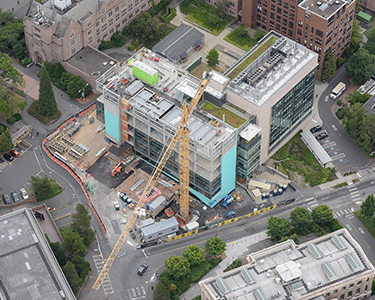|
Subscribe / Renew |
|
|
Contact Us |
|
| ► Subscribe to our Free Weekly Newsletter | |
| home | Welcome, sign in or click here to subscribe. | login |
Construction
| |
June 30, 2016
UW science building is a tough study in subcontractor demand
Journal Construction Editor
The building may be for nanoengineering, but for Hoffman Construction it has been a big challenge.
Hoffman has been working on the $87.8 million Nanoengineering & Sciences Building at the University of Washington for more than a year. Crews are now enclosing the 78,000-square-foot concrete structure with curtainwall, applying waterproofing and air barrier, roughing-in utilities, and installing thin stone shingles on the exterior walls.
The project started off with a budget of $53 million, but that changed last year when the UW decided to finish most of what it originally planned as shell space in more than 75 percent of the building. That increased the tab by about $21.8 million. Now, another $5.9 million has been added to finish the remaining shell space.
The project's “base scope” also increased — from $53 million to $60.1 million.
A Sept. 10, 2015, report from UW's board of regents said the increase in the base scope was due to unanticipated construction escalation and market conditions.
The report broke the $7.1 million increase into four main areas:
• Volatile market conditions made it difficult for Hoffman to provide consistent estimates, with estimated costs rising as the market became more volatile.
• About $2 million in mechanical scope was missed or not included in Hoffman's early estimates. The disparity was discovered in February 2015 after hiring a mechanical subcontractor and receiving the sub's initial cost estimate.
• Extremely high demand for subcontractors resulted in a poor bidding climate and reduced competition. Ten of 17 bid packages came in over budget, many significantly so, and about half of the bid packages had two or fewer bidders. In the case of the curtainwall package, no bids were received in the first round of bidding so more attempts were held to get competitive bids.
• Limited means to reduce costs were available since the building was designed and permitted and most of it was shell space. The report said the project team has worked to reduce costs as much as practically possible.
Tight markets
Hoffman superintendent Jesse Hollowell said the market for curtainwall subcontractors has been extremely tight due to the number of high-rises going up in downtown Seattle. He said a four-story building like their UW project isn't as attractive to subcontractors as a 40-story building.
To appeal to more bidders, Hoffman worked with the UW and architect ZGF to change parts of the curtainwall design. Hollowell said they replaced stainless steel panels in favor of painted aluminum panels, which are easier to get.
Even with that change, and others, the project ended up with just one bidder for the curtainwall work.
Hoffman executive vice president Bart Eberwein said they have been dealing with extraordinary circumstances in the market following the Great Recession.
Eberwein said subcontractors were hungry during the recession and prices for their services were good. As the market improved, their prices didn't go up too fast, he said. “But then the market really got better and we were blindsided by how fast prices snapped back.”
Eberwein said subcontractors are having trouble finding skilled workers since the recovery. He said subcontractors can't import workers from other parts of the country because the recovery has boosted construction business in all regions.
Steve Tatge said the university is seeing fewer subcontractor bids on its projects, with a fair amount of one or two bids, and occasionally no bids. He said some bidding volatility came as a surprise last year but now general contractors have caught up to where the market is and that's reflected in their estimates.
Tatge is executive director of major capital projects in the UW's Capital Planning and Development division.
A challenging build
Tatge said the nanoengineering project should be finished in about a year.
He said it has been challenging to build while ultra-sensitive research is ongoing in the adjoining Molecular Engineering & Sciences Building. He said researchers were puzzled for months by mysterious electromagnetic interference, only to find out the source was coming from their own instruments.
The Nanoengineering & Sciences Building will have four levels above grade and two below. Hollowell said the above-grade floors will be lab space and the first below-grade floor will be lab space housed in a concrete box designed to resist vibrations. The lowest floor will contain the building's mechanical systems.
The building connects to and matches the look of the 90,000-square-foot molecular engineering building, which Hoffman completed in 2012 at Stevens Way and Grant Lane in the science core of campus.
The two buildings will share a courtyard and essentially function as one building.
Tatge said there will be no elevators in the nanoengineering building; instead tenants will be able to walk between the buildings and use the elevators in the molecular engineering building.
The extra money needed to finish the nanoengineering project is coming from the College of Engineering and UW central funds.
About half of the overall funding — $43 million — is coming from Sound Transit to mitigate electromagnetic interference that will be caused in the future by light rail trains running in tunnels below some existing engineering buildings on campus. Sensitive instruments will be moved from those buildings into the nanoengineering building.
ZGF is the architect for both buildings. The budget for the Molecular Engineering & Sciences Building was $77 million.
Benjamin Minnick can be
reached by email or by phone
at (206) 622-8272.



